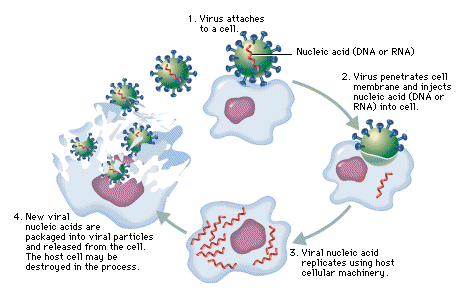Four basic Steps:
1. Attachment and entrance: the virus recognizes the host cell and attaches. The whole virus or just it’s genetic material enters the cell.
2. Synthesis of proteins: The genetic material of the virus (DNA or RNA) instructs the cell to start making viral proteins and nucleic acids (DNA/RNA)
3. Assembly of a new viruses: The viral proteins and nucleic acids are brought together to make new virus particles
4. Release of new virus particles: Newly formed virus particles are released from infected cell and then host cell dies (lysis).
Some viruses that cause cancer or infect bacteria can exist within a host cell and be dormant (inactive) until activated by some sort of environmental change. People can live with these viruses and can pass them on to other generations without ever being affected by the virus.
Treatment of Viruses
•Viruses are very difficult to treat.
•Antibiotics are ineffective as they are specific to bacteria and not viruses
•VACCINES are used to help produce an immunity to the virus
•Vaccines are a dead or weakened form of the virus and act to initiate an immune response
•Vaccines are injections or taken orally
VIRAL REPLICATION (Lytic Cycle)

